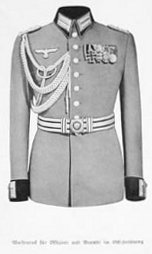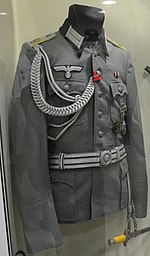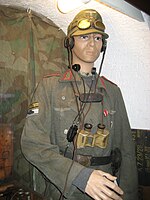Waffenrock[edit]
The Waffenrock (military coat) was descended from that introduced by the Prussian Army in 1842 and rapidly adopted by the other German states. In its Wehrmacht form as issued in 1935, it was a formfitting thigh-length eight-button tunic of fine feldgrau wool, without external pockets. The collar was taller than the service tunic and bore more elaborate Litzen, embroidered all in silver-white and mounted on Waffenfarbe backing; smaller Ärmelpatten, similar in appearance to Litzen, appeared under the buttons on the dark-green Swedish cuffs. Waffenfarbe piping also edged the collar, cuffs, front closure, and scalloped rear vent.
Officers wore a formal belt of silver braid. Trousers were steingrau, with the outer seams piped in Waffenfarbe. In the full-dress uniform (grosser Gesellschaftanzug) the Waffenrock was worn with medals, aiguillette (officers), trousers and shoes, the Schirmmütze, gloves, and sword (officers/senior NCOs) or dress bayonet (enlisted). Parade dress substituted the steel helmet and jackboots. Semi-formal (kleiner Gesellschaftanzug) and walking-out (Ausgangsanzug) uniforms were as full-dress, but without aiguillette and with ribbons replacing medals.
Production and issue of the Waffenrock was suspended in 1940, and either the service or the officers' ornamented uniform was worn for dress occasions instead. However, the Waffenrock remained authorized for walking out for those who had or could purchase it; and it was a widespread if unauthorized practice to loan a soldier a Waffenrock from regimental stocks to get married in, as evidenced by many wartime wedding photos.
Großdeutschland specific[edit]
A Waffenrock uniform was designed specifically for the Infantry Regiment Großdeutschland, however they were never widely issued and were placed in storage awaiting the end of the war.[7]
Officers' ornamented uniform (M37)[edit]
In 1937 officers were authorized the optional purchase of the "ornamented" (ornamentierte) or "piped" (mit Vorstössen) uniform, to be worn as a less-formal alternative to the Waffenrock for walking-out and some ceremonial occasions. The M37 Feldbluse was identical to the M35 service tunic, save that the collar and its Litzen were the same as the Waffenrock, and collar, closure and cuffs were piped in Waffenfarbe. It was worn with the piped dress trousers. From 1940 the M37 replaced the Waffenrock for formal and ceremonial dress.
Summer white tunic[edit]
Officers and certain senior NCOs had the option of wearing a white cotton tunic from April through September. The Reichswehr "old-style" (ältere Art) model had a stand collar, a six-button front, and plain sleeves; it was authorized for barracks wear, supervising training, and attending sporting events. The newer model introduced in 1937 had a rise-and-fall collar, an eight-button front, and French cuffs, and was authorized as a summer walking-out and undress uniform. Both versions had removable buttons, shoulderboards and metal breast eagle in order to permit laundering; collar insignia was not worn.
HBT fatigue and summer uniforms[edit]
Most recruits previous to 1940 were issued a fatigue uniform (Drillichanzug) for basic training which they kept for work details, weapons cleaning and other duties likely to soil clothes. This was an unlined, insignia-less uniform made of linen or cotton herringbone twill (HBT) that typically had two buttonless patch pockets on the skirt; enlisted versions had a standing collar while NCO and officer versions had rise-and-fall collars. The fatigue uniform originally was undyed and therefore a colour that ranged from white to oatmeal to cement grey. On 12 February 1940 the colour was ordered changed to a bluish green called "reed-green."
Since the heavy wool feldgrau uniform proved to be oppressively hot in summer weather, especially in southerly latitudes, soldiers took to wearing their lightweight green fatigue uniforms in the heat. In about 1942 the Army regularized the practice: depots began issuing an official hot-weather four-pocket field uniform of feldbluse cut but made of the same reed-green HBT material. For the enlisted Heer, these were usually worn with collar insignia and national eagle. NCOs would typically wear the summer uniform (Sommerfeldanzug) with appropriate rank on their shoulder boards, but the collar braid seen on the wool uniforms was typically absent. Two models were approved for use in the Army, the first that was designed after the M40 feldbluse and a later model that removed the front pocket pleats and pocket flap scallops similar to the M43. From 1943 a double-breasted version based on the Panzerjacke was made for vehicle and assault gun crews. SS units never had an official unique summer uniform, and while some used the Army versions, most used the earlier dyed work fatigues without insignia. While commissioned officers did have bespoke summer uniforms made, there was no regulation summer field uniform.
Originally a large black beret was worn over a hardened-felt helmet. This proved cumbersome and unnecessary and on 27 March 1940 a black version of the standard M34/M38 sidecap was authorized; later in the war the M43 field cap in black was worn. Officers frequently wore old-style (altere Art) "crusher" peaked caps.[8]
Vehicle crews in North Africa wore the same olive tropical uniform as the infantry, including collar Litzen; many tankers pinned their skull insignia to their lapels.
In 1943 the Panzertruppe were issued their own reed-green HBT summer field uniform. This resembled the black uniform but had a single, very large pocket on the left breast and another on the front of the left thigh.
A one-piece denim overall, known as a Panzerkombi, was issued to panzer (armoured) crews and mechanics for maintenance work and the like; crews sometimes wore it for general field service although the practice was discouraged. Originally issued in blue-grey, the Waffen-SS later used camouflage-printed examples. It featured zips running down the inside of the dump leg which could be used to zip both legs together to make a sleeping bag.
The similarities between the Panzer uniform and the SS uniform, led to many Panzer crewmen to be shot by Allied soldiers, who assumed the crewmen to be SS members.
 |
| Krafft Werner Jaeger, Oberleutnant |
dissabte, 24 d’agost del 2019
WEHRMACHT UNIFORMS
Subscriure's a:
Comentaris del missatge (Atom)
The Zeltbahn 31 was developed and issued first in 1931 and found its origin in the square Reichswehr tent. The Zeltbahn was patented by...

MOST POPULAR POST
-
Uniforms and insignia of the Schutzstaffel From Wikipedia, the free encyclopedia Jump to navigation Jump to search ...
-
The Heer as the German army and part of the Wehrmacht inherited its uniforms and rank structure from the Reichsheer of the W...
-
Splittertarnmuster , Splittertarn or Splittermuster ( splinter-pattern ) is a four-colour military camouflage pattern developed by G...










Cap comentari:
Publica un comentari a l'entrada